At Bar-i, we often jokingly say that we’re a bar inventory company that doesn’t like doing inventory. While this statement is made in jest, there is a grain of truth to it. We really enjoy the vast majority of our job, but we’d be lying if we didn’t admit that the process of counting inventory is very boring.
We’ve found that when bars are organized efficiently, it significantly reduces the amount of time spent on mundane tasks like counting inventory, and this makes us very happy. It allows us to focus more of our energy on the aspects of the job that we find truly rewarding, like analyzing your data, making recommendations to help improve your operations and watching your business thrive as a result of these efforts.
Regardless of the inventory system you use, keeping your bar organized will ensure that the counting process goes faster, and it will limit the number of errors that occur. The following organization tips will help you optimize the bar inventory process.
Rule 1: Product Can Go Anywhere as Long as it Always Goes in the Same Place
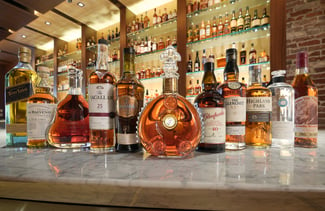 In general, it doesn’t matter how you organize your bar. There are many factors that may impact how you organize specific items behind your bar. If your primary concern is making sure that your extensive collection of high-end whiskey products is easily visible to your customers, you may decide to arrange your bottles in a way that places these items front and center. If your primary concern is making sure your bar is set up in a way that will be most efficient for your bartenders to pour drinks during your busy times, you may choose to place your high sales volume items in a location where they can be easily accessed.
In general, it doesn’t matter how you organize your bar. There are many factors that may impact how you organize specific items behind your bar. If your primary concern is making sure that your extensive collection of high-end whiskey products is easily visible to your customers, you may decide to arrange your bottles in a way that places these items front and center. If your primary concern is making sure your bar is set up in a way that will be most efficient for your bartenders to pour drinks during your busy times, you may choose to place your high sales volume items in a location where they can be easily accessed.
What’s important is that you place some thought into these decisions. As long as you and your managers come up with a sensible plan for organizing your bar, the exact order you choose will be fine. Once you decide on this order, it’s crucial that you always keep every item in its proper position behind the bar. This will make everything – from pouring drinks to restocking the bar to counting inventory – faster and more efficient. When you’re constantly rearranging the order of bottles behind the bar, it wastes time and creates confusion for your staff.
One big advantage of having a set organization for your bar is that it allows your bartenders to scan the back bar and instantly see when a bottle is missing and needs to be replaced. This ensures that all items are restocked at the end of a busy shift.
Rule 2: Make Your Organization Plan Replicable
Your bar should be organized in a way that ensures someone could put everything back in the right place without being trained. If you have a new barback and your manager is out of town for the weekend, this new employee should be able to figure out where to place every bottle after a busy shift in which the bar and storage rooms fell into a state of disarray.
Some ways to make your organization plan transparent and replicable include:
- Using labels or a mapping system – You need to have a system where your staff can see where things are meant to go so they can put everything back in its proper place. This can be accomplished by placing labels all around your bar, creating a map of the back bar, taking photos of how the bar is arranged, or creating a list that details where every item should go.
- Add pars to your labels – You can take these efforts a step further by creating pars for the labels on your shelves which indicate that a product needs to be restocked when it falls below a certain quantity behind the bar.
- Keep it simple – Our preferred way to label the bar is to use black electrical tape and a silver sharpie. In the storage room, we usually use masking tape and a black sharpie. This method is functional, waterproof, quick and easy.
Some important ideas to keep in mind when labeling your bar:
- The system needs to be effective
- It needs to be done in a way that can be changed quickly
While we strongly urge you to keep a set organizational plan, we realize that there are certain factors, such as rotating your product selection, which may cause you to slightly alter this plan over time. Therefore, your system should be easily adaptable, allowing it to evolve with your organizational plan.
Rule 3: Less is More
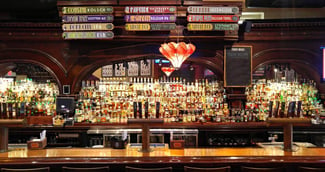 This rule refers to both product selection and rotation. Having a solid product mix and rotating these items to meet the needs of your customers can be an effective business model. However, you need to take the steps necessary to ensure this process goes smoothly:
This rule refers to both product selection and rotation. Having a solid product mix and rotating these items to meet the needs of your customers can be an effective business model. However, you need to take the steps necessary to ensure this process goes smoothly:
- It’s important that your staff can speak knowledgeably about the products you’re serving. If you don’t have the time to train your staff each time you add new items, it’s a sign that you should rotate less frequently.
- Your menus and POS system must get updated every time you rotate products. If this isn’t happening, it’s a sign that you’re rotating your products too often or that you need to update your procedures so that your staff can more easily make these updates when necessary.
It’s a lot more fun to choose new products to add to your rotation than it is to deal with the mundane tasks associated with staff education, POS updates and menu updates. As a result, many bars tend to have a larger selection than is beneficial for their business. Having a bloated product mix also ties up more money in your inventory. By cutting down on this excess inventory, you can free up money to invest in other areas of your bar’s operations.
You may be wondering if there is an ideal number of products to carry. The average bar we work with carries around 200 items. We’ve also worked with highly successful bars that carry as few as 70 items, and bars that serve upwards of 500 items. In general, we often see that the bars which carry fewer products are generating similar sales as the bars with enormous product selections. At some point, you reach a level of diminishing margin of returns in terms of the sales volume generated by carrying additional products.
We’ve also found that rotating your products less frequently and putting a great deal of thought behind the products you rotate in and out of your selection is usually more effective than constantly changing out the items you serve. In general, we’ve found that the most effective approach is to rotate your products seasonally (either every three months or every six months, depending on your business model).
Rule 4: Measure, Act, Repeat
Whatever decisions you make regarding the way you organize your bar, you should think about some reasonable ways to measure the effect of your choices. You should use these metrics to determine the changes that need to be made to your operations. Once you make these changes, measure again. Keep repeating this process in order to ensure your bar is always becoming more efficient.
Some of the metrics we recommend that you track include:
- Overall sales – This is the most fundamental metric to track. It’s easy to generate a sales report from your POS system.
- Liquor cost – This measures the amount of money you spend purchasing a product for every dollar of sales you generate. For example, a 20% liquor cost means you’re spending 20 cents to generate $1 of sales.
- Inventory/dollar ratio – This is a more advanced metric, and one which Bar-i provides in our regular inventory reports. This metric tells you how much inventory you have today compared to how much you use each week. For example, an inventory/dollar ratio of 4 indicates you have 4 times as much inventory on-hand as you use each week.
Based on our experience, we’ve found that well-run bars keep this ratio as low as 2, and it definitely shouldn’t be higher than 4. Often, we find this ratio is over 10 when we start working with bars. This means they have over 10x as much inventory on hand as they use on a given week, which is well over double what they need at any point in time. This high of a ratio is a clear sign that your financial resources aren’t being deployed properly. - Shrinkage – Another advanced metric tracked by Bar-i, shrinkage refers to the percentage of a product used which isn’t being sold. This can occur due to waste, giving the product away, or overpouring. This shrinkage hurts your liquor cost and eats into your profits.
If you don’t have objective ways to measure the effectiveness of the organizational aspects of your operations, you’re missing out on an important opportunity to be proactive about the way your bar is run. The metrics listed above provide a great starting point in terms of data to gather and track over time.
Rule 5: Count without Moving
You should set up your bar inventory in a way that it can be counted without moving a lot of stuff around. When you use our inventory system, you’ll have to pick up the bottles behind the bar to weigh them and see how much is in each bottle. We recommend that you have your bar organized in a way that makes it fast and efficient to move around counting inventory. This will reduce the amount of time it takes to perform the task, which will make your staff more likely to do it each week.
A big part of making your setup effective is to make sure you have enough storage space. If storage is limited at your bar, you can still make this process efficient by installing shelves in your storage room, keeping an appropriate amount of inventory on-hand (instead of over ordering), and maximizing the use of your space.
Rule 6: If You Open a Case, Break It Down
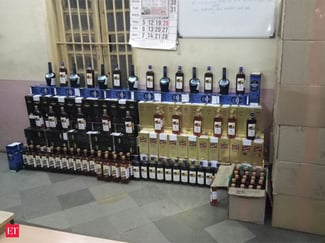 If you take a six-pack of beer or a few bottles of liquor out of a case, then you should break that case down. This allows you to:
If you take a six-pack of beer or a few bottles of liquor out of a case, then you should break that case down. This allows you to:
- Count the remaining bottles without moving them
- Eliminate the possibility of having products stacked on top of a partially full case which may not be sturdy enough to support the items stacked on top of it
- Rotate your product so that you can put new deliveries underneath the existing product, ensuring the oldest items get used first
Rule 7: Stock Like with Like
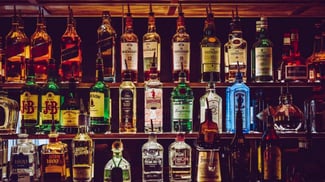 On the back bar, put all your scotches together, all your vodkas, together, all your tequilas together, and follow this process with every type of liquor you carry. This way, if a customer wants to order a glass of scotch, it’s easy for them to see all of the options.
On the back bar, put all your scotches together, all your vodkas, together, all your tequilas together, and follow this process with every type of liquor you carry. This way, if a customer wants to order a glass of scotch, it’s easy for them to see all of the options.
You should organize your storage area in the same manner (stock similar items together). This will make counting these items easier and faster. We also recommend that you keep all of your well items together and place them in a location that will be easy to access. These are high volume products, and your staff will need to grab extra bottles frequently during a shift.
Typically, there is some thought put into the order of wines on your menu. Whether you organize them by region, light body to full body, or some other method, the way these selections are arranged on your menu should provide some information about the product to your customers. We recommend that you repeat this order in your storage area because it helps staff members that aren’t very knowledgeable about wine to more easily learn about the products you carry. When your staff goes into the storage room and sees the positioning of the wine bottles, it will reinforce the thought process behind the way they are organized on the menu, giving your staff another way to recall information about the product when asked by a customer.
Rule 8: Order on the Shelf Matches the Order on the Spreadsheet (or Ideally, on Your Software)
You need to set your inventory system up in a way that ensures the order in which products are organized behind the bar matches the order in which these products are organized on the spreadsheet/software being used to record your inventory values. This will speed up the counting process and reduce the risk of counting errors.
Ideally, you should be using sophisticated inventory software to record these counts. Software is much more effective than recording this information manually using a spreadsheet and clipboard for several reasons:
- You can more easily change the order of products on software to reflect any changes you make to the way your bar is organized.
- You can set up and map out multiple areas of your bar using software. The order of products in the well and back bar are often different than the order of products in your storage area. If you have a system where you can zone out your products, it makes counting inventory much easier. You just go down the list instead of having to hunt around the page to find the specific line for the item you’re counting.
Rule 9: Always Count on the Same Day of the Week
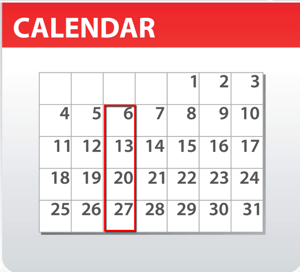 Pick a set day of the week that you always dedicate to counting inventory. Ideally, this should be a weekday since the weekend is usually the busiest time for bars. There are several benefits to always counting inventory on the same day of the week:
Pick a set day of the week that you always dedicate to counting inventory. Ideally, this should be a weekday since the weekend is usually the busiest time for bars. There are several benefits to always counting inventory on the same day of the week:
- Counting inventory will become built into the daily schedule once a week, making it more likely that it will always be completed.
- You know the inventory count will always occur on a day where your dedicated counter is working. You want to avoid having this person come in on their day off to count inventory if at all possible. Scheduling this task on your counter’s day off increases the likelihood that it won’t get done.
- The counting process becomes similar from week to week. There are lots of variables involved in generating your inventory data and if you change the day of the week when you count, you’re changing some of these variables. This can make it harder to interpret the data correctly.
In general, we recommend that you count inventory either weekly or biweekly. This will ensure you’re tracking this data regularly enough to achieve actionable information that will help you run your bar more effectively.
Rule 10: An Hour in the Morning Is Worth Two in the Afternoon
We strongly recommend that you count inventory in the morning for several reasons:
- Most people tend to be fresher in the morning than after a long shift
- The bar tends to be less busy in the morning so there are fewer interruptions
- Your counter won’t be rushing through the process in order to get done and go home since they’ll still have several hours remaining on their shift
Ideally, it’s best to count inventory early enough in the day that your bar isn’t open for business. This will keep your counter’s interruptions to an absolute minimum. To achieve this goal, you’ll usually need to count inventory first thing in the morning.
If your bar is organized in a smart and efficient manner, the counting process shouldn’t take more than an hour or two. For an average bar carrying about 200 products (this generally equates to counting about 500 items when you include back stock), your staff should be able to count inventory in about an hour and a half. We’ve found that our clients can typically count about 300 items in an hour when they use our mapping system. Our staff can consistently count 500-700 items per hour when the bar is organized well so if you choose to have us come to your bar to perform the counts, this process can go very fast.
A Well-Organized Bar Can Pay Huge Dividends
When you take the time to organize your bar efficiently, it will streamline every aspect of your inventory process. Counting goes much faster and the data you receive is more accurate. In addition, you’ll be setting your staff up for success since it will be easy for them to find the products they need during a busy rush.
If you’d like to learn more about how Bar-i can help you streamline your operations and maximize profits, please contact us today to schedule a free consultation. We serve bars and restaurants nationwide from our offices in Denver, Colorado.


-1.png)